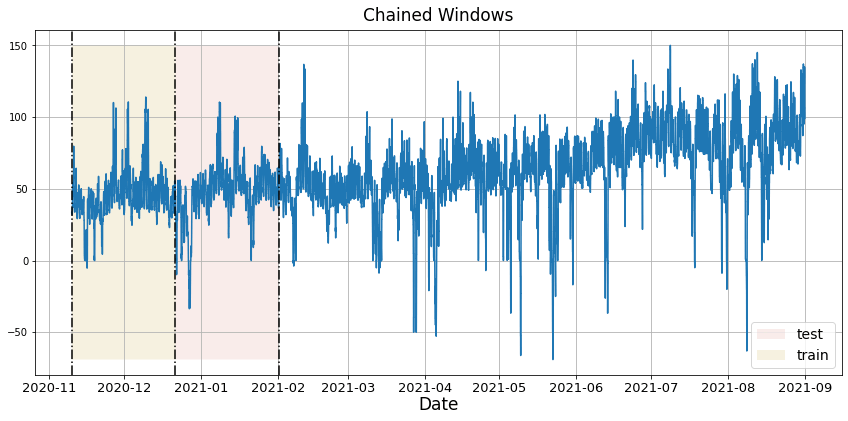Cross-validation is an effective model validation method for time series forecasting. It uses historical data to evaluate the stability and performance of your model before deployment, helping you make confident predictions in real-world scenarios.

Rolling-window cross-validation conceptually splits your dataset into multiple training and validation sets over time.
cross_validation method tailored to time series forecasting. This tutorial shows how to use NixtlaClient to run cross-validation, reinforcing the reliability of your forecasting models.
Open In Colab
For best results, ensure your data is properly formatted: you must have a time column (e.g.,
ds), a target column (e.g., y), and, if necessary, an identifier column (e.g., unique_id) for multiple time series.Goal: Validate your forecasting model systematically across different time segments.
Key Benefit:
Outcome:
Tutorial Steps
1
1. Import Packages and Initialize NixtlaClient
Cross-validation starts with installing and importing the required packages, then creating an instance of
NixtlaClient.import-packages
- Standard Usage
- Azure AI Endpoint
Use this variant if you’re connecting to Nixtla’s standard API.
standard-client
2
2. Load Example Data
Use the Peyton Manning dataset as an example. The dataset can be loaded directly from Nixtla’s S3 bucket:
load-data
3
3. Perform Cross-Validation
Why Rolling-window Cross-validation?
Why Rolling-window Cross-validation?
Time series forecasting differs from typical cross-validation because future data shouldn’t leak into model training. Rolling-window cross-validation respects time ordering by shifting the training and validation sets step by step.
Important Parameters
Important Parameters
-
freq: Frequency of your data (e.g.,'D'for daily). If not specified, it will be inferred. -
id_col,time_col,target_col: Columns representing series ID, timestamps, and target values. -
n_windows: Number of separate validation windows. -
step_size: Step size between each validation window. -
h: Forecast horizon (e.g., the number of days ahead to predict).
cross_validation on the Peyton Manning dataset:cross-validation
The logs below indicate successful cross-validation calls and data preprocessing.
Cross-validation Log Output
Cross-validation Log Output
Log Output
Cross-validation output includes the forecasted values (
TimeGPT) aligned with historical values (y).| unique_id | ds | cutoff | y | TimeGPT |
|---|---|---|---|---|
| 0 | 2015-12-17 | 2015-12-16 | 7.591862 | 7.939553 |
| 0 | 2015-12-18 | 2015-12-16 | 7.528869 | 7.887512 |
| 0 | 2015-12-19 | 2015-12-16 | 7.171657 | 7.766617 |
| 0 | 2015-12-20 | 2015-12-16 | 7.891331 | 7.931502 |
| 0 | 2015-12-21 | 2015-12-16 | 8.360071 | 8.312632 |
If you are using an Azure AI endpoint, remember to specify
model="azureai" in cross_validation. Also refer to
this tutorial to explore other supported models.4
4. Plot Cross-Validation Results
Visualize forecast performance for each cutoff period. Here’s an example plotting the last 100 rows of actual data along with cross-validation forecasts for each cutoff.
plot-results

An example visualization of predicted vs. actual values in the Peyton Manning dataset.
5
5. Use Prediction Intervals, Exogenous Variables, and Model Variations
You can customize your cross-validation further:
Features to Enhance Your Model
Features to Enhance Your Model
-
Prediction intervals: Pass
level=[80, 90]to compute confidence intervals. -
Exogenous variables: Include built-in date features like
date_features=['month'], or provide your own dynamic exogenous variables. -
Model variants: Set
model='timegpt-1-long-horizon'(or other Nixtla-supported models) for specialized tasks like long-horizon forecasts.
Example Usage
Example Usage
advanced-cross-validation
| unique_id | ds | cutoff | y | TimeGPT | TimeGPT-lo-90 | TimeGPT-hi-90 | TimeGPT-lo-80 | TimeGPT-hi-80 |
|---|---|---|---|---|---|---|---|---|
| 0 | 2015-12-17 | 2015-12-16 | 7.591862 | 7.939553 | 7.112531 | 8.730458 | 7.316611 | 8.562029 |
Conclusion
By systematically testing your forecasting models over multiple time windows,cross_validation in Nixtla’s TimeGPT ensures predictions are accurate and reliable. Incorporating confidence intervals, exogenous variables, and different model variants can further enhance your forecasts, giving you robust insights for real-world applications.
Ready to take the next step? Explore other tutorials in the Nixtla documentation for more details on custom models, hyperparameter tuning, and advanced visualization techniques.